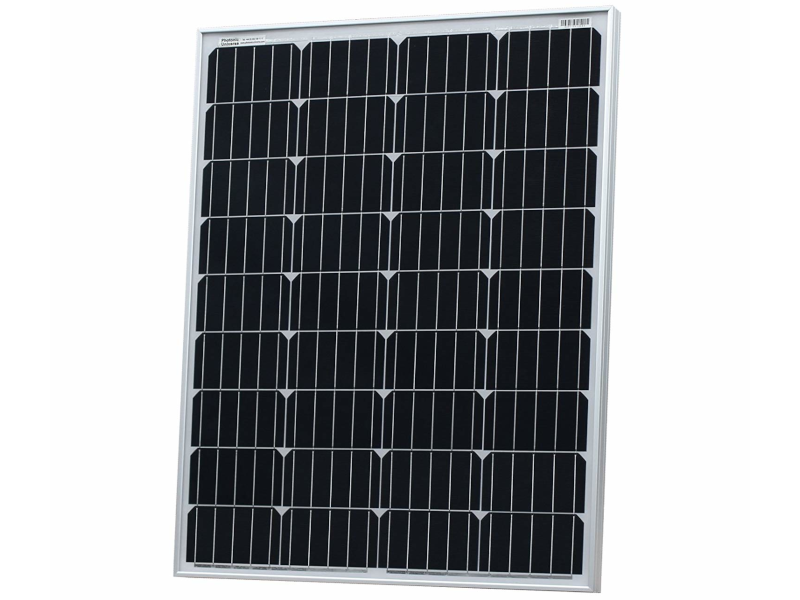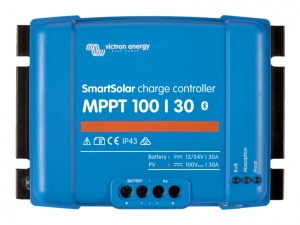| Solar Power Guide
What are Solar panels? Solar panels are mountable panels made up of photovoltaic cells which are placed together and turn sunlight into electricity through the photoelectric effect. The cells are made up of semiconducting materials (typically silicon) which are sandwiched together. These materials release electrons when hit with sunlight which then creates an electric current. Most panels are rigid, however, semi-flexible and fully flexible versions are available thanks to thin-film cells. Monocrystalline vs polycrystalline panels
There are two major types of solar panels, monocrystalline and polycrystalline, but what are their differences? Monocrystalline panels have cells that are created from a single silicon crystal which has been cut to create the cells. Polycrystalline panels have cells created by melting fragments of silicon crystals and then forming a mould, which is then cut. Due to their different constructions, this can affect the performance, look & cost of the panels. See the table below for a quick overview of the differences.
Rigid or flexible panels? The two other types of solar panels are Rigid or (Semi) Flexible. Rigid panels are typically made of solar cells housed in a tough aluminium frame which can withstand all weathers and travelling speeds. Semi-flexible panels comprise the solar cells attached to a flexible material that can conform to a slightly curved surface, which is typically reinforced with aluminium plates and have tough ETFE coatings. See the table below for a quick overview of the differences.
What size panel (or panels) do I need?
Panel performance - be realistic It's important to remember that the output power of a solar panel is not fixed. It is affected by many variables, the most significant of which are panel temperature, intensity of sunlight and direction of sunlight. A solar panel puts out its maximum power in cold, clear conditions when the sun is directly overhead and hitting the panel perpendicular to its surface. The output you will get on an overcast day or with the sun low in the sky on short, winter days will be considerably less than the theoretical maximum capability of the panel. It is, therefore, important to consider the climate and time of year in which you expect to be using the panel because this will help you understand what to realistically expect from it. Calculating your power consumption Solar calculations are generally based around Watts-hours (Wh) which is a measure of power over time. The power produced by a panel during the day is often expressed in Wh, so it is useful to convert your power consumption to Wh so you can easily compare the power you're using with the power a panel might provide. Or more simply put, 'Will the panel put back in to my battery what I take out'? First of all, you should find out the number of amps you will be drawing from each of the loads connected to your battery ('loads' simply means equipment that is drawing power from the battery) and for how long they will be powered in a 24hr period. This should based on a typical usage as it will vary from day to day. For each load you would then multiply the current draw by the number of hours for which it's powered to give you a calculation of the Amp-hours (Ah). Some example loads and corresponding Ah calculations are shown in the table below.
For these example loads you can see that in total we will be removing around 43.6 Ah of capacity from the battery in a 24 hour period. To convert this value to Watt-hours you need to multiply Ah by the voltage. To keep things simple, we'll use 12 V as the operating voltage in this example.
Using our example above: 43.6 Ah x 12 V = 523.2 Wh (per 24 hr period) We can see that we consume approximately 523 Wh during a 24 hour period, so we will need a panel (or panels) that can provide at least this much during the day to cover our usage for the entire 24 hour period. Calculating your panel's output
So now we know how many Wh are consumed per day we can work out the size of panel needed to support this by calculating the number of Wh it will produce per day. Remember that the power rating quoted by the panel manufacturer is a maximum and the output will be considerably less if the conditions are not ideal. However, for the purposes of the calculation we can make some assumptions about the time during which the maximum power is being produced, based on the winter and summer sunlight conditions. In the UK we average around 1 hour of peak sunlight in the winter and 6 hours in the summer, so if we assume that a panel is producing its maximum power for these durations, the calculation for the total Wh produced is as follows:
The table below shows this Wh calculation for various panels in winter and summer:
Alternatively, you could rearrange the above formula as follows to give you the panel size required to match your consumption:
You can see that whether you use your panel during either the winter, the summer, or both can have a very significant bearing on the panel size you'll need. In winter you'd need 2x 150W panels (or 1x 300W panel), but in summer you'd only need a 100W panel, which is a huge difference. During autumn and spring your panel requirements would probably lie somewhere between these two sizes. In reality, the mounting space available, and your budget, will limit your choice and if you use your boat or vehicle primarily during the summer, you may decide to opt for a panel size that matches your power requirements during the summer months, knowing that you'll need to supplement it during the winter months with mains hook-up or alternator charging. Other system considerations
It is important to remember that any loads that are running overnight (or any time when the panel isn't producing any power) will be consuming power from your battery and depleting its charge, so you should ensure that your battery has sufficient capacity to support the loads overnight without becoming overly discharged (max. recommended discharge for lead-acid technology batteries is around 50% to prevent sulfation).
To obtain the maximum yield and performance from your solar panel we recommend opting for a Maximum Power Point Tracking (MPPT) controller that can make the best use of your panel's capabilities. MPPT technology has a much better conversion efficiency and so is capable of harvesting more power than the older Pulse Width Modulation (PWM) technology. It is particularly beneficial in fast-changing light conditions that occur on partially cloudy days. It is worth noting that, although solar controllers have a maximum panel wattage that they can convert to charging current, this is not the maximum panel size that can be connected. In fact, you could connect a 300 W panel to a controller that could only convert 200 W of power if you knew that your 300 W panel would never actually produce that much in the climate or season in which you'll be using it. Important: The one caveat here is that the open-circuit voltage (Voc) of the panel (or connected panels), should never exceed that Voc rating of the controller as this can cause damage. Summary Calculating the size of solar panel you need is not an exact science since the daily output of a panel is dependent on a number of factors. Your available mounting space and budget obviously also have a bearing and you need to account for the time of year you'll be using it. Hopefully, this article gives you an insight into some of the aspects to consider. If you are highly dependent on solar as your main energy source (e.g. if you are off-grid or wild camping) then it will probably pay to go for the largest panel (or panels) you can afford and will fit in the space available. Conversely, if solar is a secondary power source and you have other options such as charging from your alternator or mains hook-up, then a smaller panel will probably suffice. If you are just using solar to maintain your battery during storage then you can opt for a very small panel. Disclaimer - The information contained in these articles is provided in good faith and we do our best to ensure that it is accurate and up to date, however, we cannot be held responsible for any damage or loss arising from the use or mis-use of this information or from any errors or omissions. The installer is ultimately responsible for the safety of the system so if you are in any doubt, please consult a qualified electrician. |
12 Volt PlanetAuto & Marine Electrical Components |


 Solar panels are a great way to harvest clean, free energy from sunlight & are quickly becoming commonplace on rooftops around the world. We often have customers ask what panel is right for their application so in this article we will cover the fundamental workings of solar panels, the common types available and help you understand how to calculate the panel size you require.
Solar panels are a great way to harvest clean, free energy from sunlight & are quickly becoming commonplace on rooftops around the world. We often have customers ask what panel is right for their application so in this article we will cover the fundamental workings of solar panels, the common types available and help you understand how to calculate the panel size you require.


 Battery capacity
Battery capacity Solar controllers
Solar controllers





